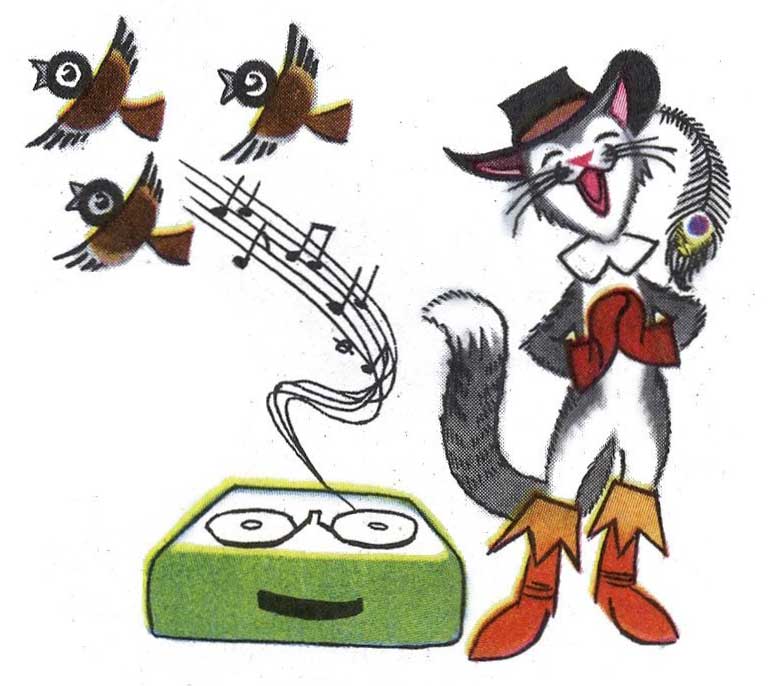Отпугиваем воробьев!
Кот в сапогах
— Если бы я спросил вас: знаете ли вы про Кота в сапогах, то, конечно, услышал бы в ответ: «Кто же не читал всем известную сказку?»
Слышать слышали, но видеть Кота в сапогах, клянусь честью, вам не приходилось. А вот профессор Д. В. Пайкин его видел. Послушайте его рассказ.
Кота внесли в дом, на дверях которого была вывеска: «Областная опытная станция». Затем его начали обувать.
Вначале каждую лапку засунули в специально сшитый мягкий ватный сапожок, который сверху завязывался чтобы кот не мог его снять.
Когда все лапки были обуты, коту надели намордник, чтобы он не кусался, и понесли на террасу. Там стояла большая клетка с воробьями. В нее-то и поместили кота в сапогах.
Увидев своего смертельного врага совсем рядом, воробьи сильно переполошились. Их охватил безумный страх, они прижались к сетке и что-то громко кричали на своем птичьем языке, наверное: «Спасите! На помощь!» — и еще что-нибудь в этом роде.
Для чего все это делалось, мне было непонятно до тех пор, пока я не заметил, что крики воробьиного ужаса записывались на магнитофонную ленту. Закончив запись, сотрудники станции унесли кота, разули его, сняли намордник и отпустили на волю.
А я услышал (теперь уже сидя у магнитофона) сначала мяуканье кота, а затем крики воробьев о нависшей над ними смертельной опасности.
— Мы выводим ценнейшие новые сорта, — объяснил мне заведующий опытной станцией. — Иногда драгоценных семян у нас бывает очень мало. Но стоит появиться всходам, как воробьи налетают на наши участки и начисто уничтожают зеленые ростки. Стрелять в них нельзя, сами понимаете. Пытались ставить огородные пугала: воробьи на них не обращали никакого внимания. Вот мы и решили записать на магнитофон крики, которые издают воробьи, увидев кота, а затем периодически пугать птиц этими криками.
Но магнитофон применяют не только для того, чтобы отпугивать птиц. Иногда ученые используют его и для привлечения осторожных хищников на писк мыши или кудахтанье кур. За последние годы начали применять звуки высокой частоты для отпугивания некоторых насекомых и грызунов. Высокочастотные звуковые колебания человеческим ухом не улавливаются. Но в одном из научных журналов рассказывается, что гусеницы кукурузного мотылька — опаснейшего вредителя кукурузы, — попав в зону распространения ультразвука определенной частоты, тут же покидают этот участок. Полагают, что можно создать ультразвуковые установки, которые будут отгонять вредителей с полей. Они действуют раздражающе на крыс и мышей, и грызуны бегут с элеваторов, комбикормовых заводов и боен, где установлена ультразвуковая аппаратура.
Так вслед за химией физика также становится на защиту урожая.
***
Puss in Boots
- If I asked you: do you know about Puss in Boots, then, of course, I would hear in response: “Who hasn’t read the well-known fairy tale?”
You have heard, but I swear on my honor that you have never seen Puss in Boots. But Professor D.V. Paikin saw him. Listen to his story.
The cat was brought into the house, on the door of which there was a sign: “Regional Experimental Station.” Then they started putting shoes on him.
First, each paw was put into a specially sewn soft cotton boot, which was tied at the top so that the cat could not remove it.
When all the paws were shod, they put a muzzle on the cat to prevent him from biting, and carried him to the terrace. There was a large cage with sparrows. That's where the cat in boots was placed.
Seeing their mortal enemy very close, the sparrows were greatly alarmed. They were seized with insane fear, they pressed themselves against the net and shouted something loudly in their bird language, probably: “Save me! For help!" - and something else like that.
Why all this was being done was unclear to me until I noticed that the screams of the sparrow’s horror were being recorded on tape. Having finished recording, the station employees took the cat away, took off his shoes, removed the muzzle and released him into the wild.
And I heard (now sitting at the tape recorder) first the meowing of a cat, and then the cries of sparrows about the mortal danger looming over them.
“We are developing the most valuable new varieties,” the head of the experimental station explained to me. “Sometimes we have very few precious seeds. But as soon as the shoots appear, sparrows fly into our plots and completely destroy the green shoots. You can’t shoot at them, you understand. They tried to set up garden scarecrows: the sparrows did not pay any attention to them. So we decided to record on tape the screams that sparrows make when they see a cat, and then periodically scare the birds with these screams.
But the tape recorder is used not only to scare away birds. Sometimes scientists use it to attract wary predators to the squeaking of a mouse or the clucking of chickens. In recent years, high-frequency sounds have begun to be used to repel certain insects and rodents. High-frequency sound vibrations are not detected by the human ear. But one of the scientific journals says that the caterpillars of the corn borer - the most dangerous pest of corn - once they get into the zone of ultrasound of a certain frequency, they immediately leave this area. It is believed that it is possible to create ultrasonic installations that will drive away pests from fields. They are irritating to rats and mice, and rodents flee from elevators, feed mills and slaughterhouses where ultrasonic equipment is installed.
So, following chemistry, physics also comes to protect the crop.
***
